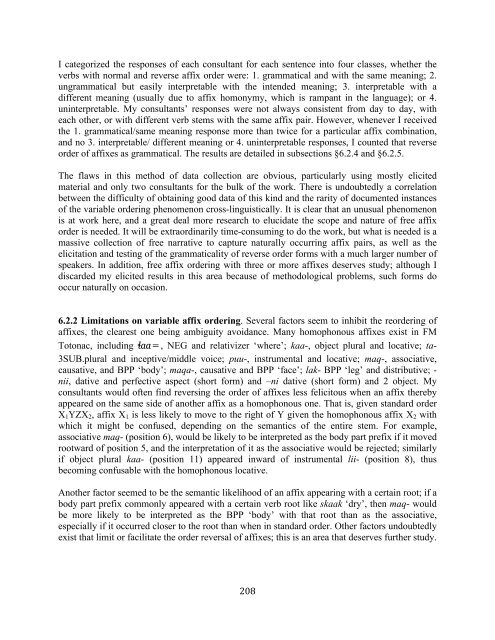The phonology and morphology of Filomeno Mata Totonac
The phonology and morphology of Filomeno Mata Totonac
The phonology and morphology of Filomeno Mata Totonac
You also want an ePaper? Increase the reach of your titles
YUMPU automatically turns print PDFs into web optimized ePapers that Google loves.
I categorized the responses <strong>of</strong> each consultant for each sentence into four classes, whether the<br />
verbs with normal <strong>and</strong> reverse affix order were: 1. grammatical <strong>and</strong> with the same meaning; 2.<br />
ungrammatical but easily interpretable with the intended meaning; 3. interpretable with a<br />
different meaning (usually due to affix homonymy, which is rampant in the language); or 4.<br />
uninterpretable. My consultants’ responses were not always consistent from day to day, with<br />
each other, or with different verb stems with the same affix pair. However, whenever I received<br />
the 1. grammatical/same meaning response more than twice for a particular affix combination,<br />
<strong>and</strong> no 3. interpretable/ different meaning or 4. uninterpretable responses, I counted that reverse<br />
order <strong>of</strong> affixes as grammatical. <strong>The</strong> results are detailed in subsections §6.2.4 <strong>and</strong> §6.2.5.<br />
<strong>The</strong> flaws in this method <strong>of</strong> data collection are obvious, particularly using mostly elicited<br />
material <strong>and</strong> only two consultants for the bulk <strong>of</strong> the work. <strong>The</strong>re is undoubtedly a correlation<br />
between the difficulty <strong>of</strong> obtaining good data <strong>of</strong> this kind <strong>and</strong> the rarity <strong>of</strong> documented instances<br />
<strong>of</strong> the variable ordering phenomenon cross-linguistically. It is clear that an unusual phenomenon<br />
is at work here, <strong>and</strong> a great deal more research to elucidate the scope <strong>and</strong> nature <strong>of</strong> free affix<br />
order is needed. It will be extraordinarily time-consuming to do the work, but what is needed is a<br />
massive collection <strong>of</strong> free narrative to capture naturally occurring affix pairs, as well as the<br />
elicitation <strong>and</strong> testing <strong>of</strong> the grammaticality <strong>of</strong> reverse order forms with a much larger number <strong>of</strong><br />
speakers. In addition, free affix ordering with three or more affixes deserves study; although I<br />
discarded my elicited results in this area because <strong>of</strong> methodological problems, such forms do<br />
occur naturally on occasion.<br />
6.2.2 Limitations on variable affix ordering. Several factors seem to inhibit the reordering <strong>of</strong><br />
affixes, the clearest one being ambiguity avoidance. Many homophonous affixes exist in FM<br />
<strong>Totonac</strong>, including "aa=, NEG <strong>and</strong> relativizer ‘where’; kaa-, object plural <strong>and</strong> locative; ta-<br />
3SUB.plural <strong>and</strong> inceptive/middle voice; puu-, instrumental <strong>and</strong> locative; maq-, associative,<br />
causative, <strong>and</strong> BPP ‘body’; maqa-, causative <strong>and</strong> BPP ‘face’; lak- BPP ‘leg’ <strong>and</strong> distributive; -<br />
nii, dative <strong>and</strong> perfective aspect (short form) <strong>and</strong> –ni dative (short form) <strong>and</strong> 2 object. My<br />
consultants would <strong>of</strong>ten find reversing the order <strong>of</strong> affixes less felicitous when an affix thereby<br />
appeared on the same side <strong>of</strong> another affix as a homophonous one. That is, given st<strong>and</strong>ard order<br />
X1YZX2, affix X1 is less likely to move to the right <strong>of</strong> Y given the homophonous affix X2 with<br />
which it might be confused, depending on the semantics <strong>of</strong> the entire stem. For example,<br />
associative maq- (position 6), would be likely to be interpreted as the body part prefix if it moved<br />
rootward <strong>of</strong> position 5, <strong>and</strong> the interpretation <strong>of</strong> it as the associative would be rejected; similarly<br />
if object plural kaa- (position 11) appeared inward <strong>of</strong> instrumental lii- (position 8), thus<br />
becoming confusable with the homophonous locative.<br />
Another factor seemed to be the semantic likelihood <strong>of</strong> an affix appearing with a certain root; if a<br />
body part prefix commonly appeared with a certain verb root like skaak ‘dry’, then maq- would<br />
be more likely to be interpreted as the BPP ‘body’ with that root than as the associative,<br />
especially if it occurred closer to the root than when in st<strong>and</strong>ard order. Other factors undoubtedly<br />
exist that limit or facilitate the order reversal <strong>of</strong> affixes; this is an area that deserves further study.<br />
! #.,!

















